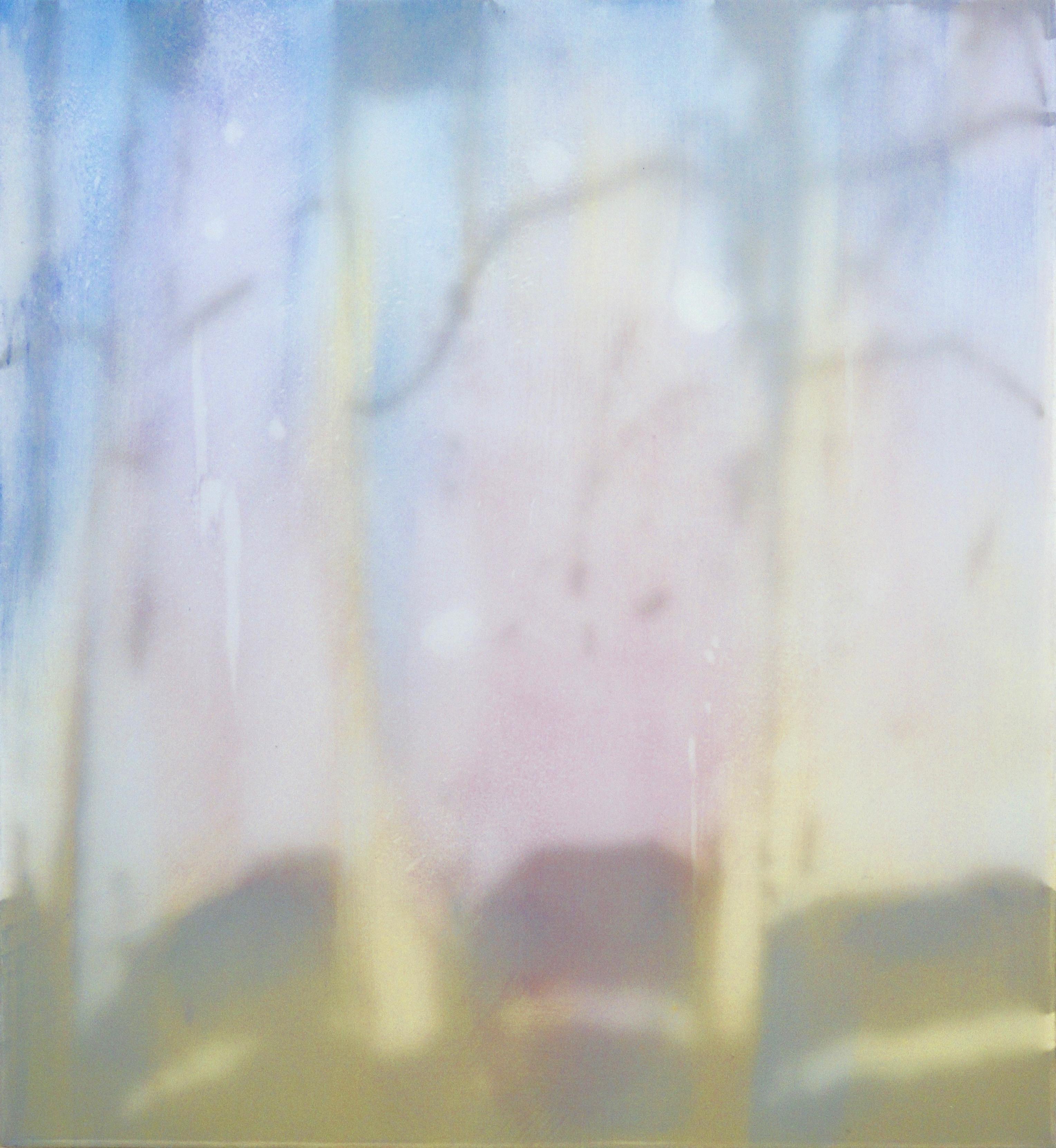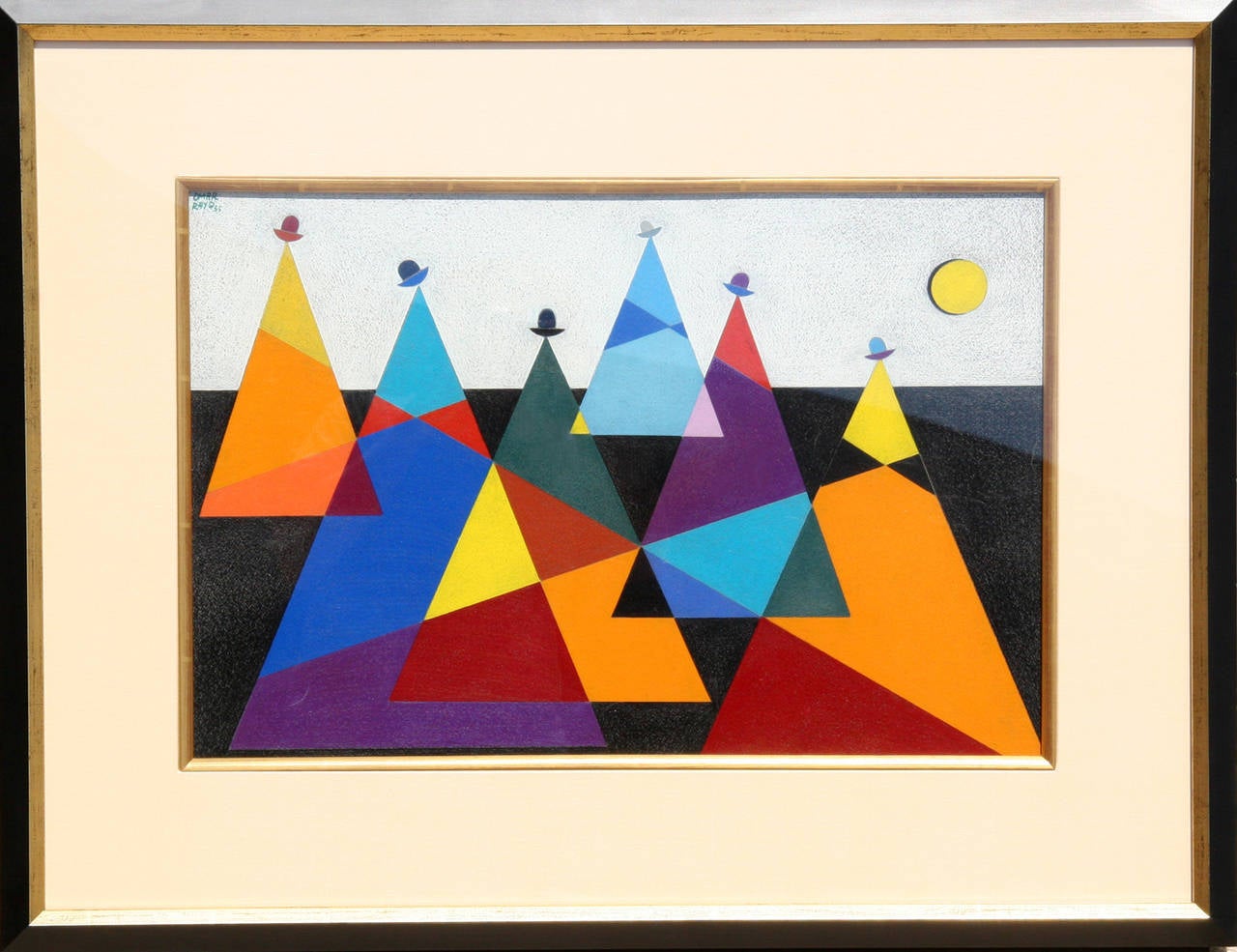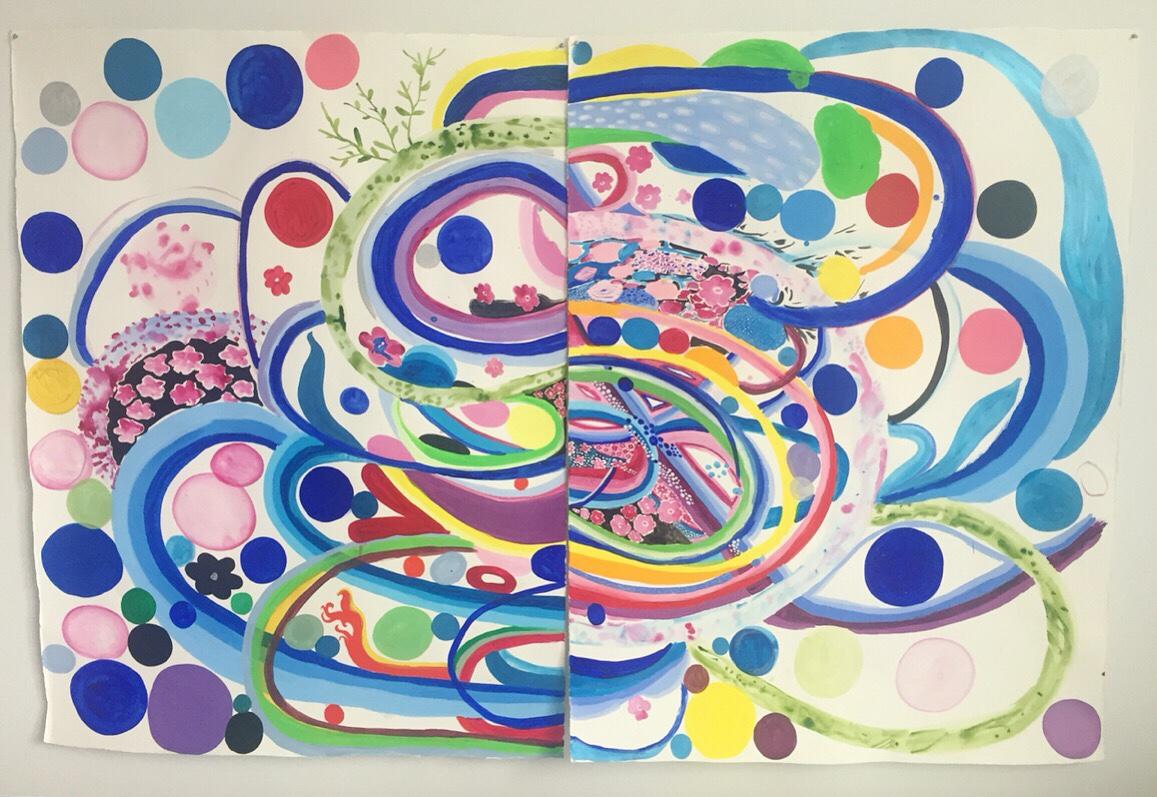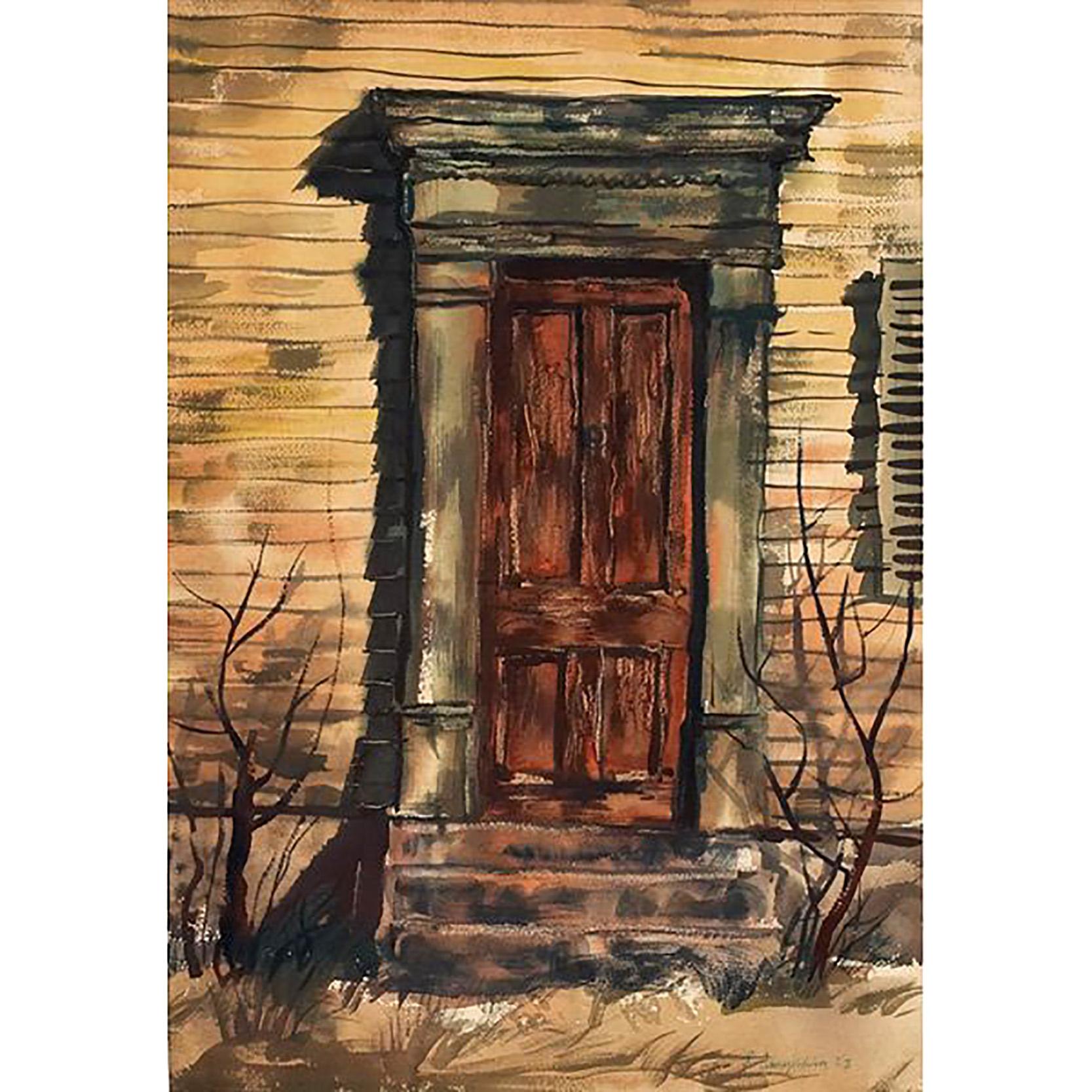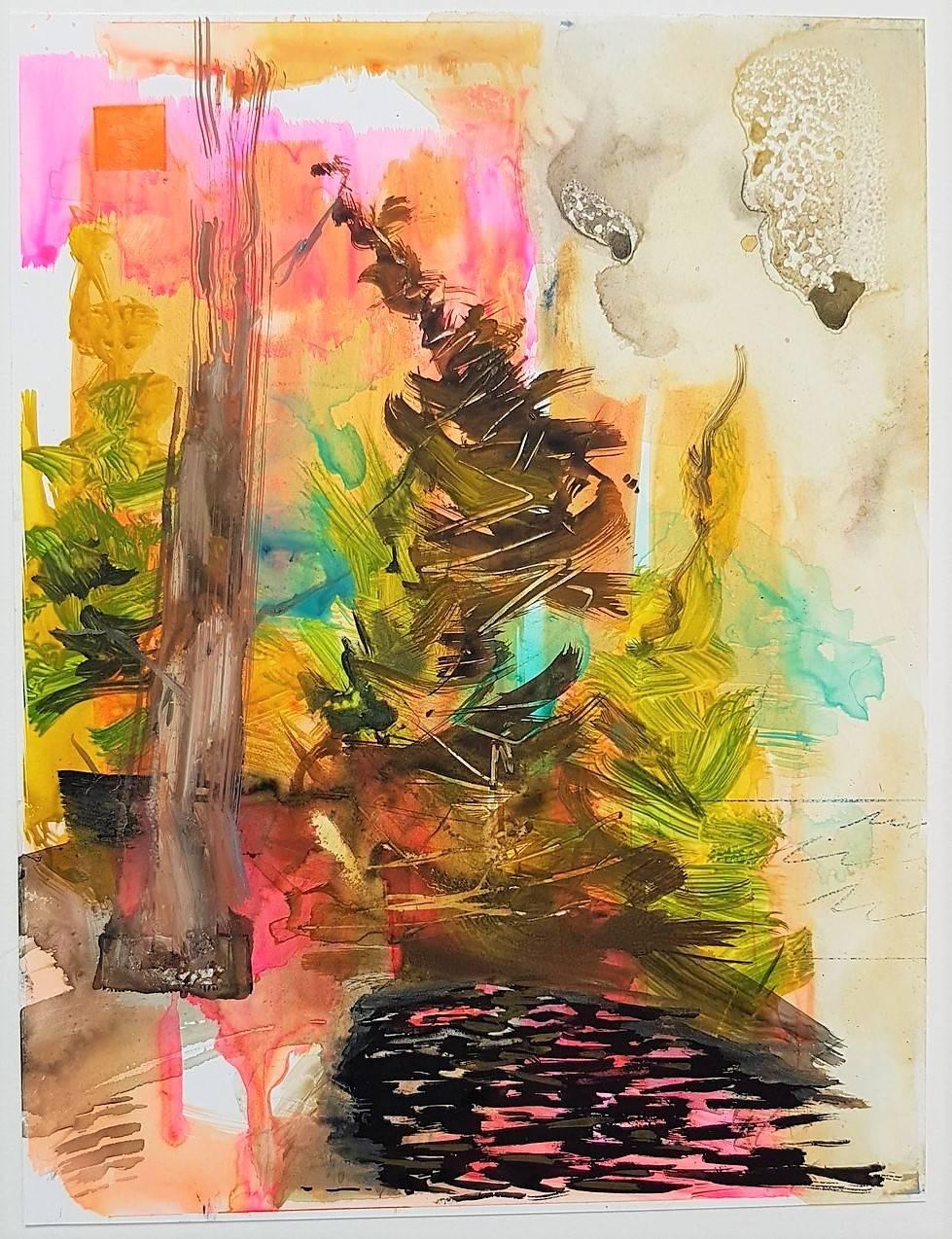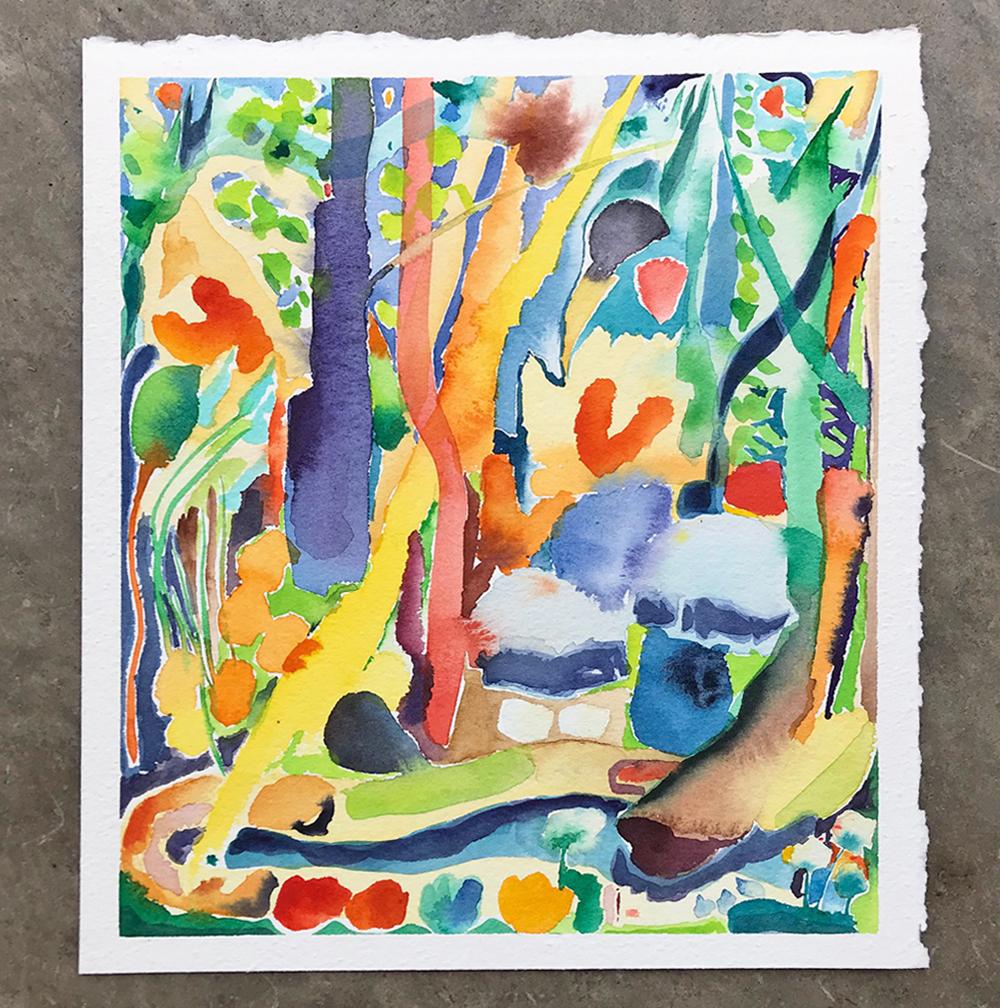Items Similar to A Small City Park, Abstract Painting Acrylic Watercolor Painting, Green Brown
Video Loading
Want more images or videos?
Request additional images or videos from the seller
1 of 16
Edward MarecakA Small City Park, Abstract Painting Acrylic Watercolor Painting, Green Brown1946-1952
1946-1952
About the Item
"A Small City Park", acrylic and watercolor on paper by Denver artist Edward Marecak (1919-1993) of an abstract park broken into four quadrants, separated by brown and white striped borders with different shaped ponds. Inspired by City Park in Denver, Colorado where the artist frequented. Presented framed with all archival materials, outer dimensions measure 21 ¾ x 18 ¾ inches. Image size measures 12 x 15 inches.
Painting is clean and in good condition - please contact us for a detailed condition report.
Provenance: Estate of Edward Marecak
Expedited and international shipping is available - please contact us for a quote.
About the Artist:
Born to immigrant parents from the Carpathian region in Slovakia, Marecak grew up with his family in the farming community of Bennett’s Corners, now part of the town of Brunswick, near Cleveland, Ohio. When he turned twelve, his family moved to a multi-ethnic neighborhood of Poles, Czechs, Slovaks and Slovenians in Cleveland. His childhood household cherished the customs and Slavic folk tales from the Old Country that later strongly influenced his work as a professional artist. During junior high he painted scenery for puppet shows of "Peter and the Wolf," awakening his interest in art. In his senior year in high school he did Cézanne-inspired watercolors of Ohio barns at seventy-five cents apiece for the National Youth Administration. They earned him a full scholarship to the Cleveland Institute of Art (1938-1942) where he studied with Henry George Keller whose work was included in the 1913 New York Armory Show. In 1940 Marecak also taught at the Museum School of the Cleveland Institute.
Before being drafted into the military in 1942, he briefly attended the Cranbrook Academy of Art near Detroit, one of the nation’s leading graduate schools of art, architecture, and design. A center of innovative work in architecture, art and design with an educational approach built on a mentorship model, it has been home to some of the world’s most renowned designers and artists, including Eero Saarinen, Charles Eames, Daniel Libeskind and Harry Bertoia. Marecak’s studies at Cranbrook with painter Zoltan Sepeshy and sculptor Carl Milles were interrupted by U.S. army service in the Aleutian Islands during World War II.
Following his military discharge, Marecak studied on the G.I. Bill at the Colorado Springs Fine Arts Center from 1946 to 1950, having previously met its director, Boardman Robinson, conducting a seminar in mural painting at the Cleveland Institute of Art. Although he did not work with Robinson at the Fine Arts Center, who had become quite ill - retiring in 1947 - he studied Robinson’s specialty of mural painting before leaving to briefly attend the Cranbrook Academy in 1947. That same year he returned to the Fine Arts Center, studying painting with Jean Charlot and Mary Chenoweth, and lithography with Lawrence Barrett with whom he produced some 132 images during 1948-49.
At the Fine Arts Center he met his future wife, Donna Fortin, whom he married in 1947. Also a Midwesterner, she had taken night art courses at Hull House in Chicago, later studying at the Art Institute of Chicago with the encouragement of artist Edgar Britton. After World War II she studied with him from 1946 to 1949 at the Fine Arts Center. (He had moved to Colorado Springs to treat his tuberculosis.) Ed Marecak also became good friends with Britton, later collaborating with him on the design of large stained glass windows for a local church.
In 1950-51 Marecak returned to the Cleveland Institute of Art to complete his Bachelor of Fine Arts degree. A year later he was invited to conduct a summer class at the University of Colorado in Boulder, confirming his interest in the teaching profession. In 1955 he received his teaching certificate from the University of Denver. Vance Kirkland, the head of its art department, helped him get a teaching job with the Denver Public Schools so that he and his family could remain in the Mile High City. For the next twenty-five years he taught art at Skinner, Grove, East, George Washington and Morey Junior High Schools.
Prior to coming to Colorado, Marecak did watercolors resembling those of Winslow Homer, John Singer Sargent and Charles Burchfield. However, once in Colorado Springs he decided to destroy much of his earlier ouevre, embarking on a totally new direction unlike anything he had previously done. Initially, in the 1940s he was influenced by surrealist imagery and Paul Klee, and in the West by Indian petroglyphs and Kachinas. His first one-person show at the Garrett Gallery in Colorado Springs in 1949 featured paintings and lithographs rendered in the style of Magic Realism and referential abstraction. The pieces, including an oil Witch with Pink Dish, foreshadowed the output of his entire Colorado-based career, distinguished by a dramatic use of color, intricacy of execution and attention to detail contributing to their visual impact. He once observed, "Each time I start a new painting I always fool myself by saying this time keep it simple and not get entangled with such complex patterns, color and design; but I always find myself getting more involved with richness, color and subject matter."
An idiosyncratic artist proficient in oil, acrylic, watercolor, gouache and casein, he did not draw upon Colorado subject matter for his work, unlike many of his fellow painters in the state. Instead he used Midwest landscape imagery, bringing to life in it witches and spirits adapted from the Slovakian folk tales he heard growing up in Ohio. A number of his paintings depict winter witches derived from the Slovak custom in the Tatra Mountains of burning an effigy of the winter witch in the early spring to banish the memory of a hard winter. The folk tale element imparts a dream-like quality to many of his paintings.
A devote of Greek mythology, he placed the figures of Circe, Persephone, Sybil, Hera and others in modern settings. The goddess in Persephone Brings a Pumpkin to her Mother, attired as a Midwestern farmer’s daughter, heralds the advent of fall with the pumpkin before departing to spend the winter season in the underworld. Train to Olympus, the meeting place of the gods in ancient Greece, juxtaposes ancient mythology with modernity creating a combination of whimsy and thought-provoking consideration for the viewer. Voyage to Troy #1 alludes to the ancient city that was the site of the Trojan Wars, but has a contemporary, autobiographical component referencing the harbor of the Aleutian Islands recaptured from the Japanese during World War II. In the 1980s Marecak used the goddess Hera in his painting, Hera Contemplates Aspects of the Art Nouveau, to comment on art movements in the latter half of the twentieth century
Marecak’s love of classical music and opera, which he shared with his wife and to which he often listened while painting in his Denver basement studio, is reflected in Homage of Offenbach, an abstract work translating the composer’s musical colors into colorful palette. Pace, Pace, Mio Dio, the title of his earliest surrealist painting, is a soprano aria from Verdi’s opera, La Forza del Destino (The Force of Destiny or Fate, a favorite Marecak subject). His Queen of the Night relates to a character from Mozart’s opera, The Magic Flute.
In addition to paintings and works on paper, he produced hooked rugs, textiles and ceramics. He likewise produced designs for ceramics, tableware and furniture created by his wife Donna, an accomplished Colorado ceramist.
Both of them generally eschewed exhibitions and galleries, preferring to quietly do their work while remaining outside of the mainstream. He initially exhibited at the Colorado Springs Fine Arts Center in 1948 receiving a purchase award. The following year he had his first one-person show of paintings and lithographs at the Garrett Gallery in Colorado Springs. In the 1950s and early 1960s he participated in group exhibitions at the Print Club (Philadelphia); Amarillo Public Library (Texas); annual Blossom Festival Show (Canon City, Colorado); Adele Simpson’s "Art of Living" in New York; Denver Art Museum; and the Fox Rubenstein-Serkey Gallery (Denver); but he did not have another one-person show until 1966 at the Denver home of his friends, John and Gerda Scott. They arranged for his first one-person show outside of Colorado held two years later at the Martin Lowitz Gallery in Beverly Hills and Palm Springs, California. That same year his work was featured at the Zantman Galleries in Carmel, California.
Thereafter he became an infrequent exhibitor after the 1970s so that his work was rarely seen outside his basement studio. In 1980 he, his wife and Mark Zamantakis exhibited at Denver’s Jewish Community Center, and four years later he had a one-person show at the Studio Gallery in Denver. In 1992 he was included in a group show at the Rule Modern and Contemporary Gallery in Denver, and a year later received a large, posthumous retrospective at the Emmanuel Gallery, also in Denver.
Museum Collections: Colorado Springs Fine Arts Center; Denver Art Museum; Kirkland Museum of Fine & Decorative Art, Denver.
©Stan Cuba for David Cook Galleries, LLC
- Creator:Edward Marecak (1919 - 1993)
- Creation Year:1946-1952
- Dimensions:Height: 18.75 in (47.63 cm)Width: 21.75 in (55.25 cm)Depth: 1.25 in (3.18 cm)
- Medium:
- Movement & Style:
- Period:
- Condition:
- Gallery Location:Denver, CO
- Reference Number:
About the Seller
5.0
Platinum Seller
These expertly vetted sellers are 1stDibs' most experienced sellers and are rated highest by our customers.
Established in 1979
1stDibs seller since 2013
264 sales on 1stDibs
Typical response time: 5 hours
- ShippingRetrieving quote...Ships From: Denver, CO
- Return PolicyA return for this item may be initiated within 7 days of delivery.
More From This SellerView All
- Gold Mining, Homestake Mine, South Dakota, 1940s Abstract Landscape WatercolorLocated in Denver, COGouache and watercolor on paper painting, painted in 1948 by Mary Chenoweth (1918-1999). Signed and dated by the artist in the lower right corner. Depicting an abstracted landscape o...Category
1940s Abstract Abstract Drawings and Watercolors
MaterialsWatercolor, Gouache, Archival Paper
- Mill Near Plainfield, New Hampshire, Landscape Painting, Charles Partridge AdamsBy Charles Partridge AdamsLocated in Denver, CO"Mill Near Plainfield, New Hampshire" is an original, signed watercolor painting by artist Charles Partridge Adams (1858-1942), circa 1900. Singed by the artist in the lower left corner. Portrays a mill along a river with trees and clouds, painted in shades of brown, green, gray, and blue. Presented in a custom frame, outer dimensions measure 13 ¾ x 12 ¼ x 1 ¼ inches. Image size is 7 x 5 inches. Expedited and international shipping is available - please contact us for a quote. About the Artist: Born Massachusetts, 1858 Died 1942 Born in Franklin, Massachusetts, Charles Partridge Adams moved with his mother and two sisters to Denver, Colorado, in 1876 in an effort to cure the two girls who suffered from tuberculosis. In Denver, Adams found work at the Chain and Hardy Bookstore. He received his first, and only, art training from the owner's wife, Helen Chain. Mrs. Chain, a former pupil of George Inness, provided instruction and encouragement to the young artist and introduced him to other artists in the area including Alexander Phimister Proctor...Category
20th Century American Modern Landscape Drawings and Watercolors
MaterialsWatercolor, Archival Paper
- Modernist Trees, 1940s Framed Modernist Landscape Watercolor Painting, Red GreenBy Richard SorbyLocated in Denver, COModernist painting of trees, interior forest scene by Colorado artist, Richard Sorby (1911-2001). Painted in dark colors of green, blue and black with brown, orange and white. Water...Category
1940s American Modern Landscape Drawings and Watercolors
MaterialsWatercolor, Archival Paper
- Colorado Mountain Winter Landscape Watercolor Painting, Blue, Orange, PurpleLocated in Denver, COColorado mountain landscape watercolor painting signed by artist Rita Derjue (1934-2020) depicts Cabins in the Snow in bright tones of blue, yellow, green and red/brown. Signed by the artist in the lower right corner. Presented in a custom frame with archival materials, outer dimensions measure 24 ⅛ x 31 ½ x 1 ¼ inches. Image sight size is 14 ½ x 21 ½ inches. About the Artist: Born Rhode Island, 1934 Artist, educator, mentor and community activist, Derjue is the daughter of European parents whose family members had previous connections with New York and New England. Her drawing talent as a youngster in Rhode Island caught the attention of family friend Johann Groen, a Dutch-born painter and photographer, who encouraged her to spend time touring and studying in Europe to further her art education. In 1956 she earned her Bachelor of Fine Arts degree at the Rhode Island School of Design that emphasized the fundamentals of drawing and design. Her most memorable teacher was Richard Hamilton, whose work was influenced by German Expressionist Max Beckmann and the jazz greats. Her studies from nature and Cubist compositions done at that time reflect her interest in early twentieth-century European modernist painting. She had the opportunity to experience it firsthand during a year of post-graduate work at the renowned Akademie den Bildenden Kunste in Munich, Germany, in 1956-57. She studied with Ernest Geitlinger (1895-1972) whom the Nazi government classified as a “degenerate” artist in the 1930s, preventing him from exhibiting in Germany. After World War II he was one of the co-founders of the Munich artists’ association, Neue Gruppe, in 1946 and played an important role in abstract painting. While studying with him in Munich she produced a number of canvases in a referential abstract style. She also became acquainted with the Blaue Reiter group that flourished in the early twentieth century and whose expressionism strongly influenced her color palette and painting style. She particularly admired the work of Blaue Reiter co-founder and Wassily Kandinsky’s long-time partner, Gabriele Münter, whose work she studied at the Lenbachhaus in Munich and at the Gabriele Münter Haus and the Schlossmuseum in Murnau south of Munich. Derjue’s immersion in German Expressionism imparted a bold, simplified style to her work. In 1958 with a friend from Munich she went to Mexico for a year, studying with artist Frank Gonzalez in his studio in San Angel, Mexico City, and with Canadian artist, Toni Onley, in San Miguel de Allende. Onley had recently won a scholarship to the Instituto Allende to study mural and fresco painting with David Siqueiros, one of the three greats of Mexican muralism. At the Instituto Onley began painting large black-and-white canvases in an abstract impressionistic style which he imparted to Derjue, who thereafter began exploring color and space in the dimensions of her own large compositions. With writer Gregory Strong, he subsequently published Onley’s Arctic and his autobiography, The Tony Onley Story. After returning to the United States, she worked as a graphic designer for Little, Brown and Company, publishers in Boston. She began dating her future husband, Carle Zimmerman, whom she met earlier in Europe and whom she married in 1960. Joining him at Cornell University where he was completing his Ph.D degree, she earned her Master of Arts degree at the same institution and participated in group shows at the Herbert F. Johnson Museum and the Munson-Williams-Proctor Arts Institute in upstate New York. In 1963 Derjue and her husband relocated to Littleton, Colorado, where he spent his entire career, first as a research engineer and later as a departmental manager for the Marathon Oil...Category
20th Century American Modern Landscape Paintings
MaterialsWatercolor, Archival Paper
- 1930s Colorado Modernist Landscape Painting of Trees, Mountains & HousesLocated in Denver, COColorado Modernist landscape, watercolor on paper by Turner B. Messick (1878-1952) from 1938. Tree with houses and mountains in the background, pain...Category
1930s American Modern Landscape Paintings
MaterialsArchival Paper, Watercolor
- Windmill on the Plains, 1940s Watercolor and Ink Mixed Media Modernist PaintingBy Jenne MagafanLocated in Denver, CO'Windmill on the Plains' is watercolor and ink on paper painting by Jenne Magafan. Depicting a large windmill on a 1940s Colorado farm scene with sheds and a fencing in the backgroun...Category
1940s American Modern Landscape Drawings and Watercolors
MaterialsPaper, Ink, Watercolor
You May Also Like
- WINDOW V - Contemporary Abstract Mixed Media Painting, shadow, curtains, blueBy Heather HartmanLocated in Signal Mountain, TNWINDOW V captures the soft patterned shadow of the trees veiled by a sheer curtain. This painting is is part of an on-going series that explores the light and landscape in Tennessee....Category
2010s Abstract Abstract Paintings
MaterialsPolyester, Oil, Acrylic, Gouache, Mesh
- MountainsBy Omar RayoLocated in Long Island City, NYAn early painting by Omar Rayo from 1955. An abstract geometric work with multi-colored shapes on a surrealist horizon. Artist: Omar Rayo, Colombian (1928 - ) Title: Mountains Year:...Category
1950s Abstract Geometric Abstract Paintings
MaterialsPaper, Acrylic
- Wide and Wild Big DiptychBy Nina BovassoLocated in New York, NYThis is a large diptych on paper, 68 x 101 inches, created in 2020. What is unique to this one is the wider horizontal width. I think of my large diptychs as simultaneously a figure...Category
2010s Abstract Paintings
MaterialsAcrylic, Watercolor, Gouache, Archival Paper, Ink
- Old DoorBy Richard AnuszkiewiczLocated in New York, NYRichard Anuszkiewicz Old Door, 1953 Watercolor on paper Signed and dated by the artist on the lower right front 20 × 14 inches Unframed This unique and extre...Category
1950s Abstract Geometric Landscape Drawings and Watercolors
MaterialsPaper, Watercolor
- Untitled (Abstract, Vibrant, Drips, Neon, Gestural, Contemporary, Expressionism)By Russell ShoemakerLocated in Kansas City, MORussell Shoemaker Title: Untitled Year: 2018 Medium: Gouache on Yupo Paper Size: 12 x 9 inches Signed, dated and inscribed by the artist Russell Shoemaker received his BFA from the ...Category
2010s Abstract Impressionist Landscape Drawings and Watercolors
MaterialsGouache, Synthetic Paper
- "Rose Breasted Mazurka" Watercolor Painting - abstract, landscape, colorfulBy Kurt HerrmannLocated in Marmora, NJKurt Herrmann 10x11” (26x28 cm) unframed watercolor on paper 2022 Artist Watercolor statement: I went to Siberia in 1994 for the adventure and to paint. I came home with my first ...Category
2010s Hard-Edge Abstract Paintings
MaterialsWatercolor
Recently Viewed
View AllMore Ways To Browse
Vintage City Painting
Small Framed Paintings
Small Abstract Paintings
Small Paintings In Frames
World Wars Painting
Small Black Painting
Philadelphia Painting
Park City
New York City Painting Print
Green And Brown Painting
Library Painting
Small Size Painting
Small Art In Acrylic
Painting Of A Library
Small Painting Modern
Small White Paintings
Park City Art
Vintage Love Paintings
